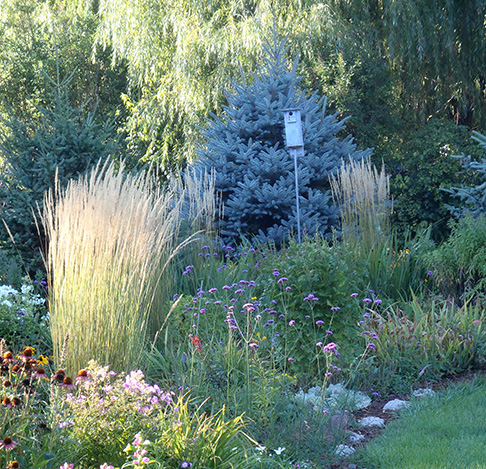I first saw this plant in my neighbor’s garden. The landscape designer she hired had planted it in her front perennial bed which also included a variety of roses. Her verbena was situated in the center of the new garden and it grew taller than the rest of the plants. It looked great with the roses and made a beautiful architectural statement with slender stems that did not need to be staked. Those stems branched out near the top and bloomed with dainty lilac/purple flower clusters that filled in the empty spaces of the garden much like adding babies breath as a filler to a flower bouquet.
I watched those plants all that first year and noticed that they had a very long bloom time, basically from summer until frost. When those same plants emerged the next year, I told her how much I admired her garden and asked for the name of her tall purple plant. She was very helpful, told me that it was called “Tall Verbena” and gave me some of her verbena “volunteers” that had sprouted from the previous year. Since it was a tender perennial, the parent plants had died and her new plants were from seeds that had dropped the previous autumn.
We dug some up and I planted my tall verbena volunteers in a few different areas. That year I found out that while they look great in a spot that you can see through, they seemed to disappear when planted next to my blue gray house. The verbena had an airy, see-through habit, which made it a good choice for the front or middle of a mixed border, but not in the back of a garden located next to a building. I also found that tall verbena was best planted in columns or masses because it was so thin it could be missed as a single plant and looked much better clumped with a few verbena friends. Another great feature was that since it didn’t cast much of a shadow you could see other plants behind and under it.
I really like verbena bonariensis or (tall verbena) and found it to be very easy to grow. Butterflies love it and they visit our garden all summer long. I love the airy see through quality it lends to my perennial garden and while it self sows rather freely I find it is easy to keep under control. I just wait until the plants sprout in the spring and pull out volunteers growing where I don’t want them.
Research
Light: Does best in full sun but can tolerate a little bit of shade.
Moisture: Verbena bonariensis is fairly drought tolerant.
Height: 2 to 4 feet
Hardiness: This verbena is a perennial in USDA zones 7-11 and grown as an annual in cooler climates. Most of my tall verbena plants come from seed, but occasionally I have a parent plant that survives our Wisconsin winter and enjoys a second year in the garden.
Propagation: Easily propagated from seed. It also can be started from cuttings of young branch tips in spring or summer, or by dividing the rooted clumps of young shoots in spring.






I didn’t know verbena attracted butterflies. Sounds like a plan for next spring. Thanks!
I have bought this a few times, but it never propagates in my garden. I might try it again and save seed.